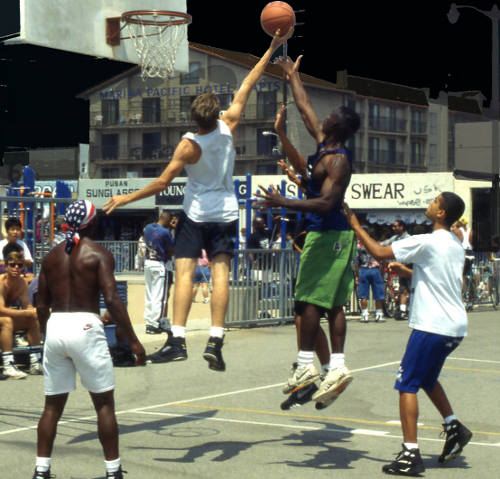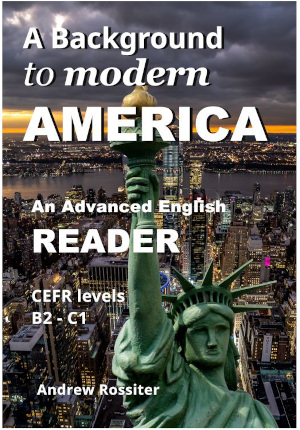
Crime-time basketball
An unusual sports program for disadvantaged young people in the USA
Linguapress
American society
Yet today Alfred is a student at Atlanta's Clark University, his self respect has returned, and he's looking forward to getting a proper job. It's all down to basketball.... and a bit more.
 Basketball
offers something different to do on a warm night.
Basketball
offers something different to do on a warm night.
It comes easily at any time of day, of course; but at night it comes more easily still. The middle of the night is prime time for crime, and it always has been, specially when the nights are warm and it's good to be out of doors.
Yet the level of crime in America's big cities has fallen considerably over the last two decades. In some cities, such as New York, the fall has been spectacular, and though America's cities may still be dangerous places at night, compared to most European cities, the improvement is real.
One reason for this improvement is statistical; the number of young men in the 15-25 age group has fallen. However there are other factors too, including stricter policing; but less spectacularly, perhaps, there are also the numerous programs that have been set up, by cities and volunteer groups, to provide young people with alternatives to crime.
While Curtis Sliwa's Guardian Angels showed New Yorkers, then people in other cities, that tough young men could be just as happy and effective combating crime as participating in it, many other programs have also helped bring down the crime rate. The idea behind them all is much the same; to give people something constructive or enjoyable to do, and channel their efforts away from crime.
The concept of Midnight Basketball was first launched in 1986 in Maryland, by a retired federal employee, G. Van Standifer working at the time as town manager at Glendarden, a suburb of Washington. The federal capital has one of the highest rates of criminality in the U.S.A..
Faced with an "escalating crime rate" among "at risk" young men, mostly Blacks, Van Standifer saw that one of the main reasons for the rapidly worsening situation was boredom, the fact that young men had nothing to do - or at least, nothing they could afford to do, given that few of them had jobs.
With the help of some friends and volunteers, he set up the first Midnight Basketball program, opening the doors of a local sports center from 10 p.m. to 2 a.m., and inviting in anyone who wanted a game. Word soon got round, and before long groups of Glendarden's young men were dropping in to take part or cheer on their friends.
The idea spread, and before long other cities and urban areas started opening up facilities to encourage young men in off the streets for basketball; by the early 90's, Midnight Basketball programs were running in 44 American cities, and a network of regional leagues was established. In 2020, thirty-four years later, after some ups and downs, the concept of Midnight Basketball is still going strong, and Midnight Basketball tournaments are organised in many US cities, such as New Orleans, Newark and San Antonio. The idea has even spread to Australia..
However, there is more to Midnight Basketball than just playing ball; there are conditions. Many players first take part in a "HOPE" session, HOPE being an acronym for Helping Other People Evolve.
Hope is a commodity that is often in short supply in America's run-down inner cities; at Midnight Basketball HOPE sessions, educators, community leaders and people with useful skills show 17-25 year olds how they can improve their situation in life. Pre-game seminars concentrate on subjects such as getting a job, respect for women, and developing skills. When appropriate, participants are encouraged to get back into education of some sort. Many participants in the Midnight Basketball program are indeed high school dropouts, with no skills and no qualifications; for some, Midnight Basketball provides an opening that they would never otherwise have had.
Alfred Jones is just one young man from the suburbs of Atlanta who has been successful; others, in other US cities, have done as well as he has, or even better. Alternatively, like Tony Johnson from San Francisco, they have got jobs. "I've changed my life completely," says Tony, who now has a full-time job with Nestlé. Previously, Tony's life was just "hangin' on the streets, bein' a menace, sellin' drugs."
Not all Midnight Basketballers will end up with a job or a qualification; not all will abandon crime. "It brings a lot of criminals to one spot and keeps 'em off the streets 'til it's over," says a San Francisco cop, without much enthusiasm. In San Francisco, as elsewhere, uniformed cops regularly sit in with the spectators, as trouble can flare up easily at Midnight Basketball sessions.
Yet for many, Midnight Basketball has provided at least a first foot back on the road to hope; and that is a chance that, without it, they might never have had.
WORDS
dropout: failure - down to: a result of - tough: hard - guys: men - provide with: give - crime rate : number of crimes - channel: direct - retired: former, who used to be - cheer on: applaud - league: championship - is in short supply: there is not enough of it - skill: practical aptitude
Copyright notice.
This resource is © copyright Linguapress renewed 2024. Updated from an article originally published in Spectrum magazine.
This text may not be reproduced on other websites nor in printed form without written permission from the publishers. Reproduction is authorised exclusively for personal use by students, or for use by teachers with their classes.
Student worksheet
Crime-time
Basketball
1. Synopsis:
Here's a 350- word synopsis of the article. There are twenty words missing.
Here is a list of 24 words in alphabetical order - the 20 missing words plus four others which you will neo need. Put each missing word back in the text in the right place.
age,
alternatives, another, Australia, behind, before, beyond, dropouts,
drugs, early, jobs,
late, never, night, nothing, other, past, rates, respecting, suburb,
to,
while, worse, York
In
many poor areas of American cities, crime is a common path for young
men who lack ,
money, and opportunities. This problem becomes at night, when
young people have
to do and crime feels
like the easiest option. However, over the 20 years,
crime
in American cities have dropped significantly.
In cities like New ,
the change has been dramatic. This decline
is partly due to fewer young men in the 15 - 18 group, better
policing, and community programs that offer to crime.
One such program is Midnight Basketball, which started in 1986 in Glendarden, a of Washington, D.C. The founder, G. Van Standifer, saw that many young men turned crime because they were bored and had no safe or affordable activities at . With support from volunteers, he opened a night-time sports center (10 p.m. to 2 a.m.) where young men could come to play basketball instead of being on the streets. The idea quickly spread across the country, and by the 1990s, Midnight Basketball programs were active in 44 cities. Today, they continue in places like New Orleans, Newark, and San Antonio, and have even reached countries like .
Midnight Basketball is more than just a game. playing, participants often attend "HOPE" sessions, which stands for Helping People Evolve. These sessions provide guidance on life skills, finding jobs, others, and returning to education. Many players are high school with few qualifications. For some, Midnight Basketball is their first real chance to change their lives.
Some participants, like Alfred Jones from Atlanta and Tony Johnson from San Francisco, have used the program to turn their lives around. Tony, who once sold , now works for Nestlé. Still, not every player leaves crime . Some police officers remain skeptical, seeing the games as simply gathering places for troublemakers. Yet, for many young men, Midnight Basketball offers hope and a new path—something they might have found without it.
One such program is Midnight Basketball, which started in 1986 in Glendarden, a of Washington, D.C. The founder, G. Van Standifer, saw that many young men turned crime because they were bored and had no safe or affordable activities at . With support from volunteers, he opened a night-time sports center (10 p.m. to 2 a.m.) where young men could come to play basketball instead of being on the streets. The idea quickly spread across the country, and by the 1990s, Midnight Basketball programs were active in 44 cities. Today, they continue in places like New Orleans, Newark, and San Antonio, and have even reached countries like .
Midnight Basketball is more than just a game. playing, participants often attend "HOPE" sessions, which stands for Helping People Evolve. These sessions provide guidance on life skills, finding jobs, others, and returning to education. Many players are high school with few qualifications. For some, Midnight Basketball is their first real chance to change their lives.
Some participants, like Alfred Jones from Atlanta and Tony Johnson from San Francisco, have used the program to turn their lives around. Tony, who once sold , now works for Nestlé. Still, not every player leaves crime . Some police officers remain skeptical, seeing the games as simply gathering places for troublemakers. Yet, for many young men, Midnight Basketball offers hope and a new path—something they might have found without it.
2. Rearrange the words to make questions that relate to the article above
.......then answer them.
1) Q. the / is / crime / time / when / prime / for ?
The question:
The answer: .
2) Q. the / spectacular / fall / been / has / where / crime / in ?
The question:
The answer: .
3) Q. reasons / are / improvement / what / for / the / this ?
The question:
The answer: .
4) Q. the / what / behind / is / programs / idea / the ?
The question:
The answer: .
5) Q. the / launched / was / concept / when / Basketball / of / first / Midnight ?
The question:
The answer: .
6) Q. situation / was / of / reasons / what / the / one / main / worsening / for ?
The question:
The answer: .
7) Q. part / today / many / men / how / young / take ?
The question:
The answer: .
The question:
The answer: .
2) Q. the / spectacular / fall / been / has / where / crime / in ?
The question:
The answer: .
3) Q. reasons / are / improvement / what / for / the / this ?
The question:
The answer: .
4) Q. the / what / behind / is / programs / idea / the ?
The question:
The answer: .
5) Q. the / launched / was / concept / when / Basketball / of / first / Midnight ?
The question:
The answer: .
6) Q. situation / was / of / reasons / what / the / one / main / worsening / for ?
The question:
The answer: .
7) Q. part / today / many / men / how / young / take ?
The question:
The answer: .
3. Written exercise:
Before writing this article, the Linguapress.com reporter might have talked to G. Van Standifer. Imagine eight questions that the reporter could have asked, and the answers that Van Standifer might have given. Vary the questions. Include at least one question with each of the following question words:Why, when, where, how long, what, how many, Has... Did ....
4. Independent interactive cloze-exercise - may be done without consulting the text.
Read the following text, and complete it by adding sixteen appropriate words, one in each box. In some cases a number of words may be possible, in others there is only one possibility. Time: 20 minutes.
The concept of
Midnight Basketball was
first launched in 1986 in Maryland,
a retired federal
employee, G. Van Standifer working at the time as town manager at
Glendarden, a suburb of Washington. The federal capital has one of the
highest
of
criminality in the U.S.A..
Faced with an "escalating crime rate" among "at risk" young men, mostly Blacks, Van Standifer saw that one of the main reasons for the rapidly worsening situation was boredom, the fact that young men had nothing to do - or at least, nothing they afford to do, given that of them had jobs.
With the help of some friends and volunteers, he set up the first Midnight Basketball program, opening the of a local sports center 10 p.m. to 2 a.m., and inviting in anyone who wanted a game. Word soon got round, and long groups of Glendarden's young men were dropping in to part or cheer on their friends.
The idea spread, and soon other cities and urban areas started opening up facilities encourage young men in off the streets for basketball; by the early 90's, Midnight Basketball programs were in 44 American cities, and a network of regional leagues was established. In 2020, thirty-four years , after some ups and downs, the concept of Midnight Basketball is going strong, and Midnight Basketball tournaments are organised in many US cities, as New Orleans, Newark and San Antonio. The idea has even spread to Australia..
However, there is more to Midnight Basketball than just playing ball; there are conditions. Many players first take part in a "HOPE" session, HOPE being an acronym for Helping Other People Evolve.
Hope is a commodity that is often in short supply in America's run-down inner cities; at Midnight Basketball HOPE sessions, educators, community leaders and people with useful skills show 17-25 year olds they can improve their situation in life. Pre-game seminars concentrate on subjects such as a job, respect for women, and developing skills. When appropriate, participants are encouraged to get back into education of some sort. Many participants in the Midnight Basketball program are indeed high school dropouts, with no skills and no qualifications; for some, Midnight Basketball provides an opening that they would never otherwise had.
Faced with an "escalating crime rate" among "at risk" young men, mostly Blacks, Van Standifer saw that one of the main reasons for the rapidly worsening situation was boredom, the fact that young men had nothing to do - or at least, nothing they afford to do, given that of them had jobs.
With the help of some friends and volunteers, he set up the first Midnight Basketball program, opening the of a local sports center 10 p.m. to 2 a.m., and inviting in anyone who wanted a game. Word soon got round, and long groups of Glendarden's young men were dropping in to part or cheer on their friends.
The idea spread, and soon other cities and urban areas started opening up facilities encourage young men in off the streets for basketball; by the early 90's, Midnight Basketball programs were in 44 American cities, and a network of regional leagues was established. In 2020, thirty-four years , after some ups and downs, the concept of Midnight Basketball is going strong, and Midnight Basketball tournaments are organised in many US cities, as New Orleans, Newark and San Antonio. The idea has even spread to Australia..
However, there is more to Midnight Basketball than just playing ball; there are conditions. Many players first take part in a "HOPE" session, HOPE being an acronym for Helping Other People Evolve.
Hope is a commodity that is often in short supply in America's run-down inner cities; at Midnight Basketball HOPE sessions, educators, community leaders and people with useful skills show 17-25 year olds they can improve their situation in life. Pre-game seminars concentrate on subjects such as a job, respect for women, and developing skills. When appropriate, participants are encouraged to get back into education of some sort. Many participants in the Midnight Basketball program are indeed high school dropouts, with no skills and no qualifications; for some, Midnight Basketball provides an opening that they would never otherwise had.
Teachers section : Using this article in class
Listening comprehension:After you have been through this text twice with your students, have them hide the text as you read to article out loud.
Stop reading at each of the | marks in the following extract. Get students to try and remember how the text continued. If you wish to continue with the whole article in this way, decide beforehand where to break.
The phrases in italics following the pauses illustrate points of syntax or structure (underlined), or fact, vocabulary and pronunciation (not underlined).
Crime comes easily to many
young men in |
the tough parts
of America's cities; it's almost second |
nature, specially to guys who | have
no jobs and no money, and | nothing
to do.
It comes easily at | any time of day, of course; but at night it comes | more easily still. The middle of the night is | prime time for crime, and it always | has been, specially when the nights are warm and it's good to be | out of doors.
Yet the level of crime in America's big cities has | fallen considerably over | the last two decades. In some cities, such | as New York, the fall | has been spectacular, and though America's cities may | still be dangerous places at night, compared to most European cities, the | improvement is real.
One reason | for this improvement is statistical; the number of young men in the | 15 to 25 age group has fallen. However there are other factors | too, including stricter | policing; but less spectacularly, perhaps, there are also the | numerous programs that have been | set up, by cities and volunteer groups, to provide young people with | alternatives to crime.
It comes easily at | any time of day, of course; but at night it comes | more easily still. The middle of the night is | prime time for crime, and it always | has been, specially when the nights are warm and it's good to be | out of doors.
Yet the level of crime in America's big cities has | fallen considerably over | the last two decades. In some cities, such | as New York, the fall | has been spectacular, and though America's cities may | still be dangerous places at night, compared to most European cities, the | improvement is real.
One reason | for this improvement is statistical; the number of young men in the | 15 to 25 age group has fallen. However there are other factors | too, including stricter | policing; but less spectacularly, perhaps, there are also the | numerous programs that have been | set up, by cities and volunteer groups, to provide young people with | alternatives to crime.
Comprehension - open cloze exercise.
The open cloze (gap fill) exercise is one of the Reading and Use of English activities included in Cambridge Advanced (CAE) or Proficiency (CPE) testing.Teachers: you may want to use this exercise with your class, as an unprepared use of English activity, before introducing them to the whole article
Other ideas?
EFL teachers: Help develop this resource by contributing extra teaching materials or exercises.
Click here for further details
This teaching resource is © copyright Linguapress Revised 2021 . Originally published in Spectrum, the Advanced level English newsmagazine.
Republication on other websites or in print is not authorised



 Copyright
information.
Copyright
information.